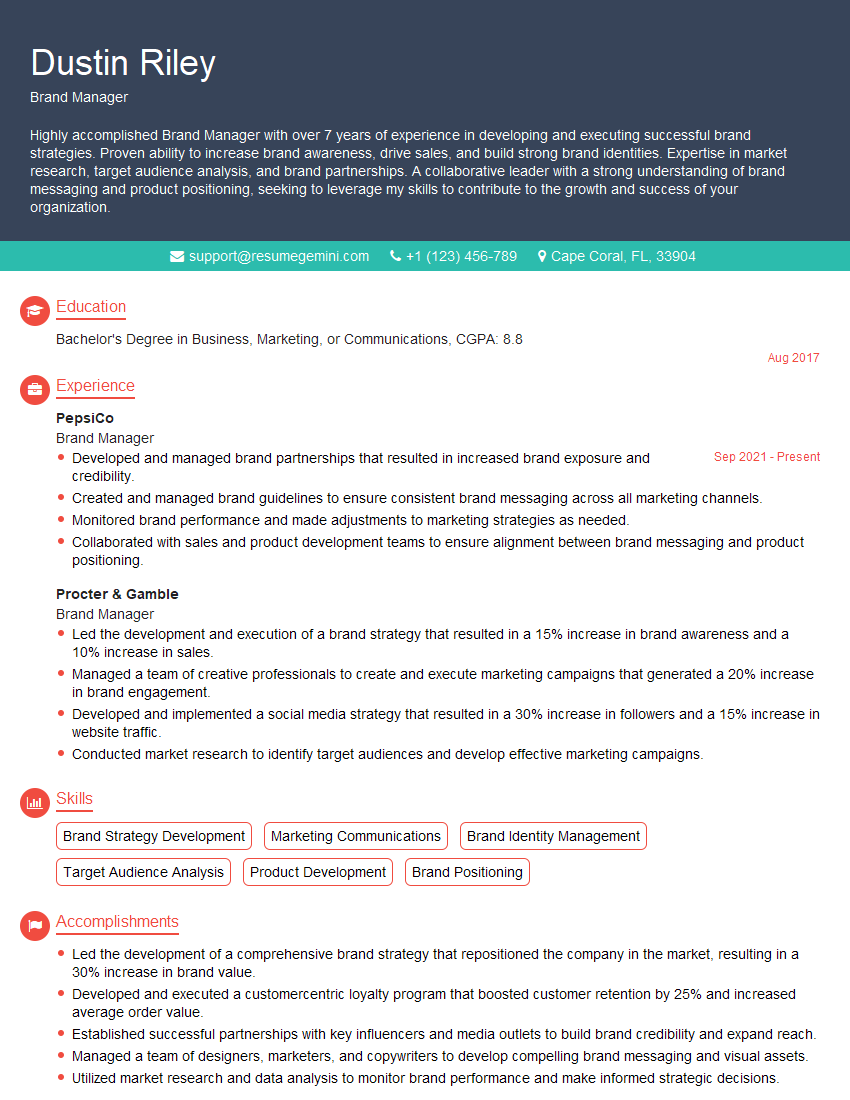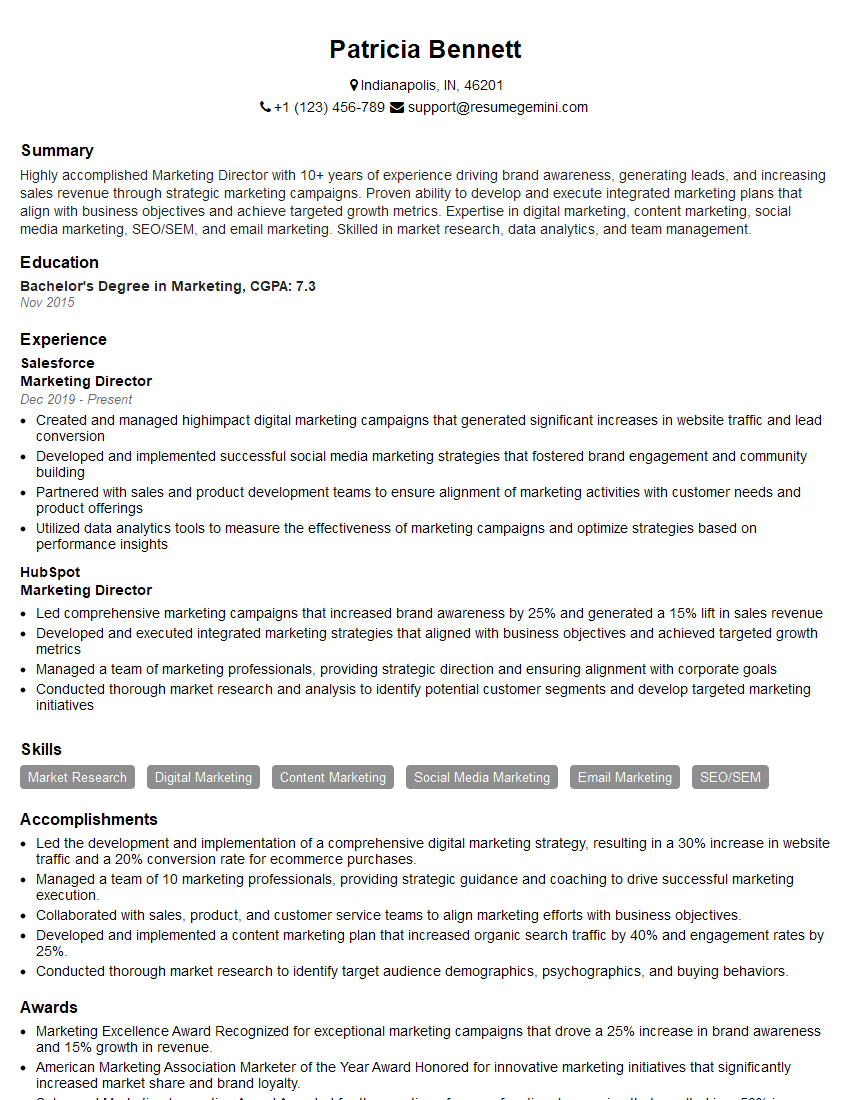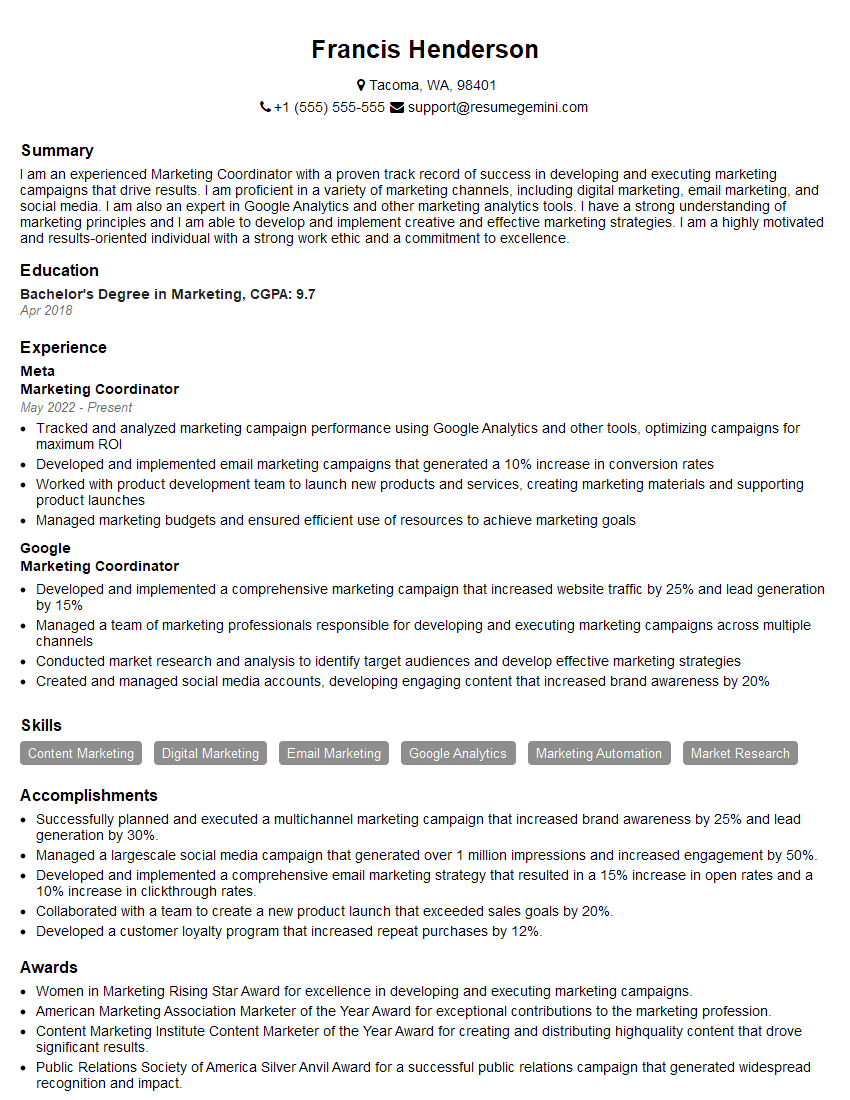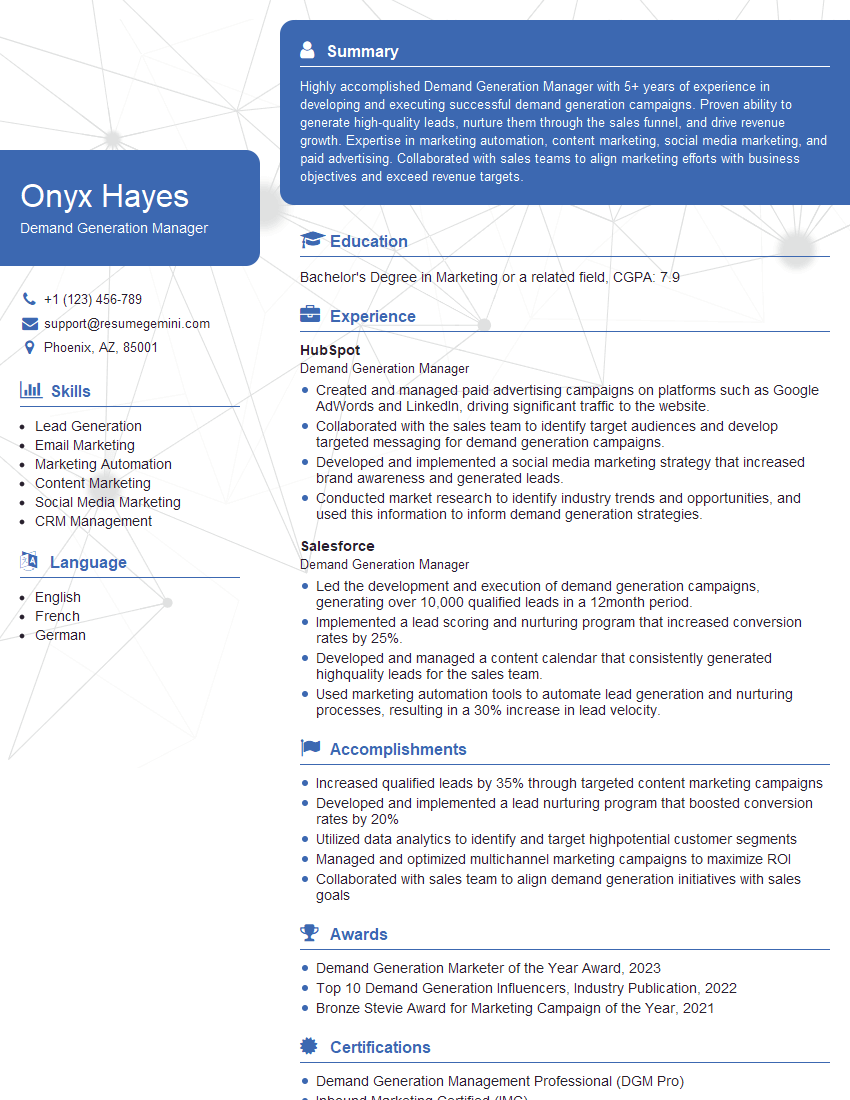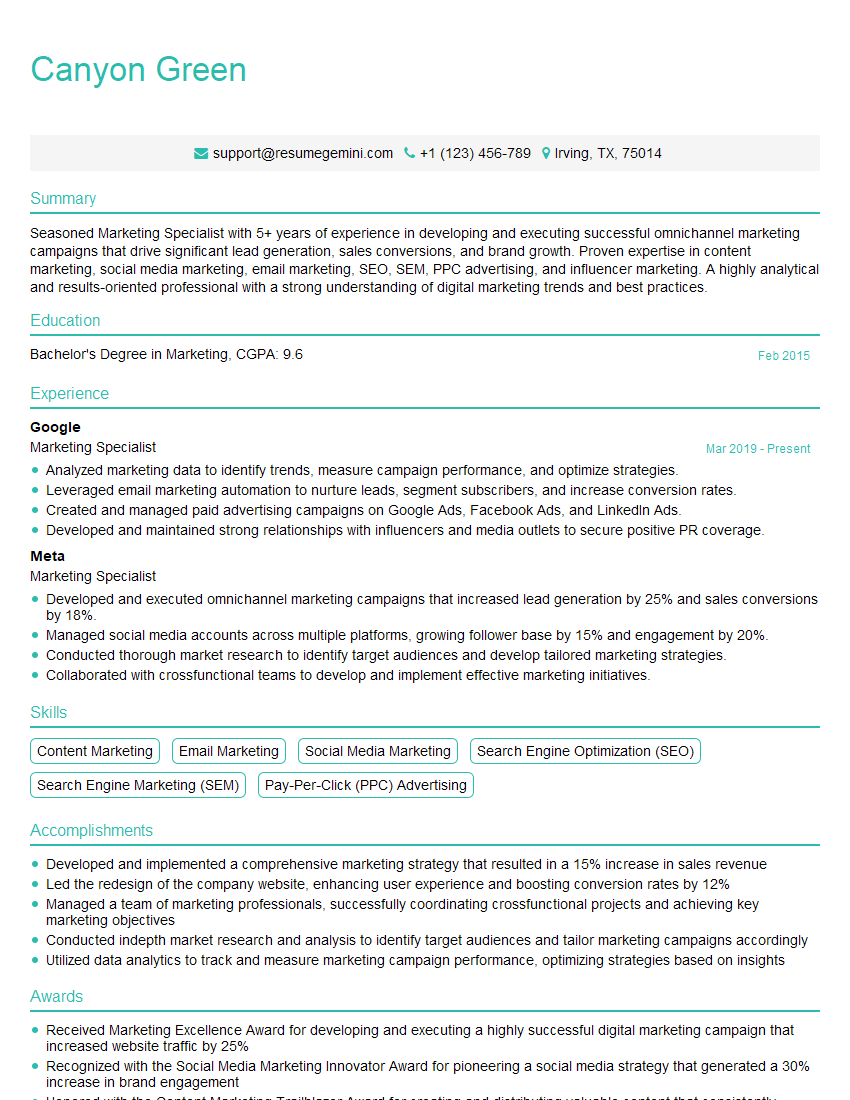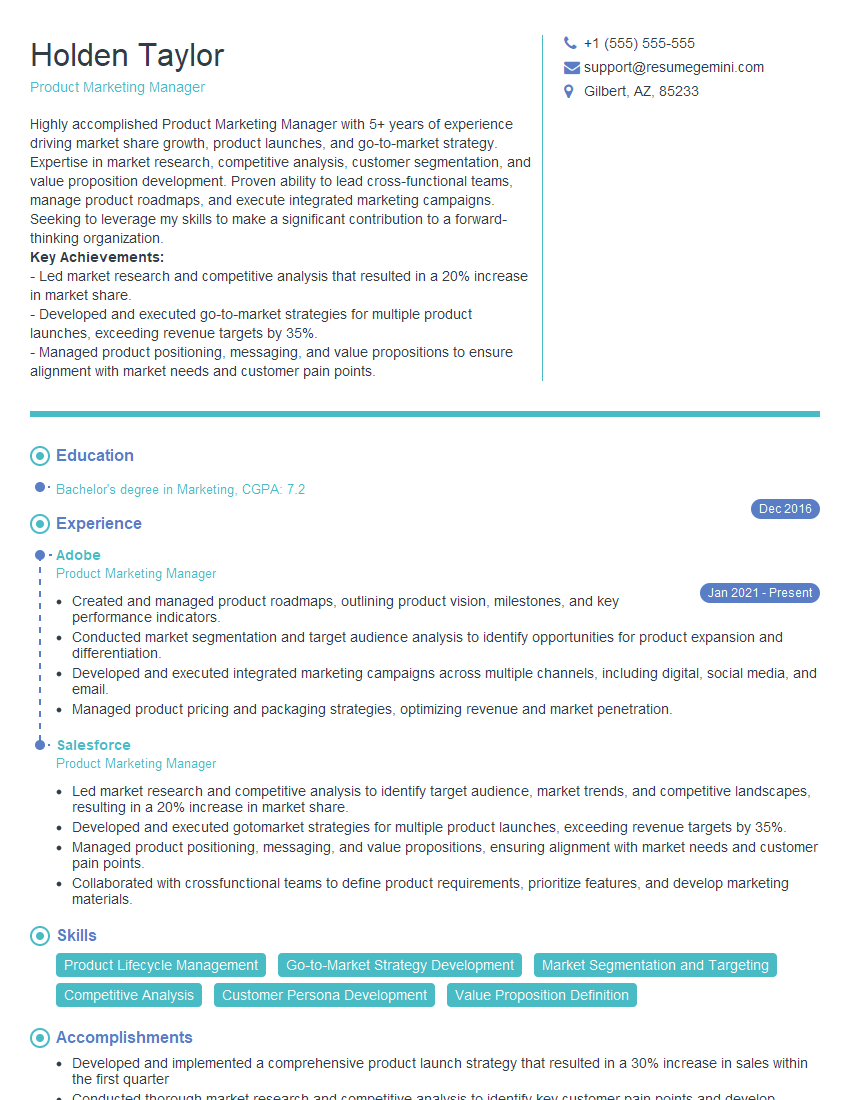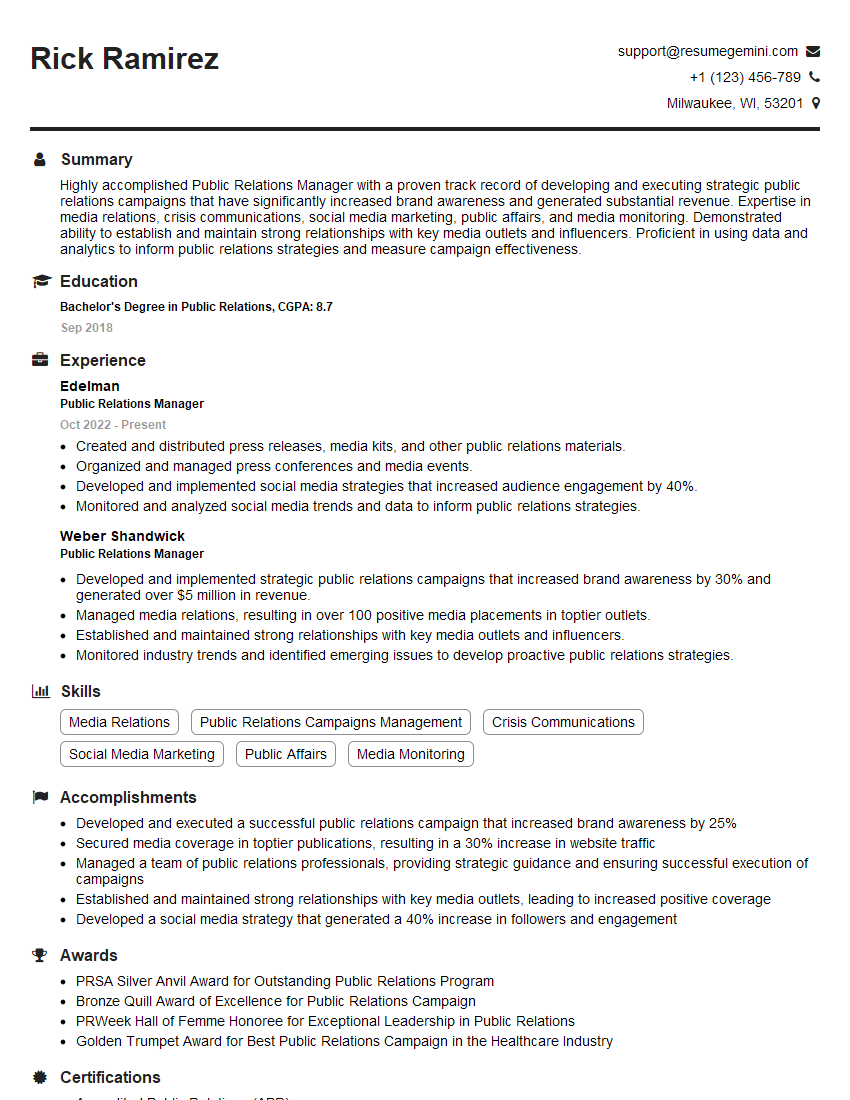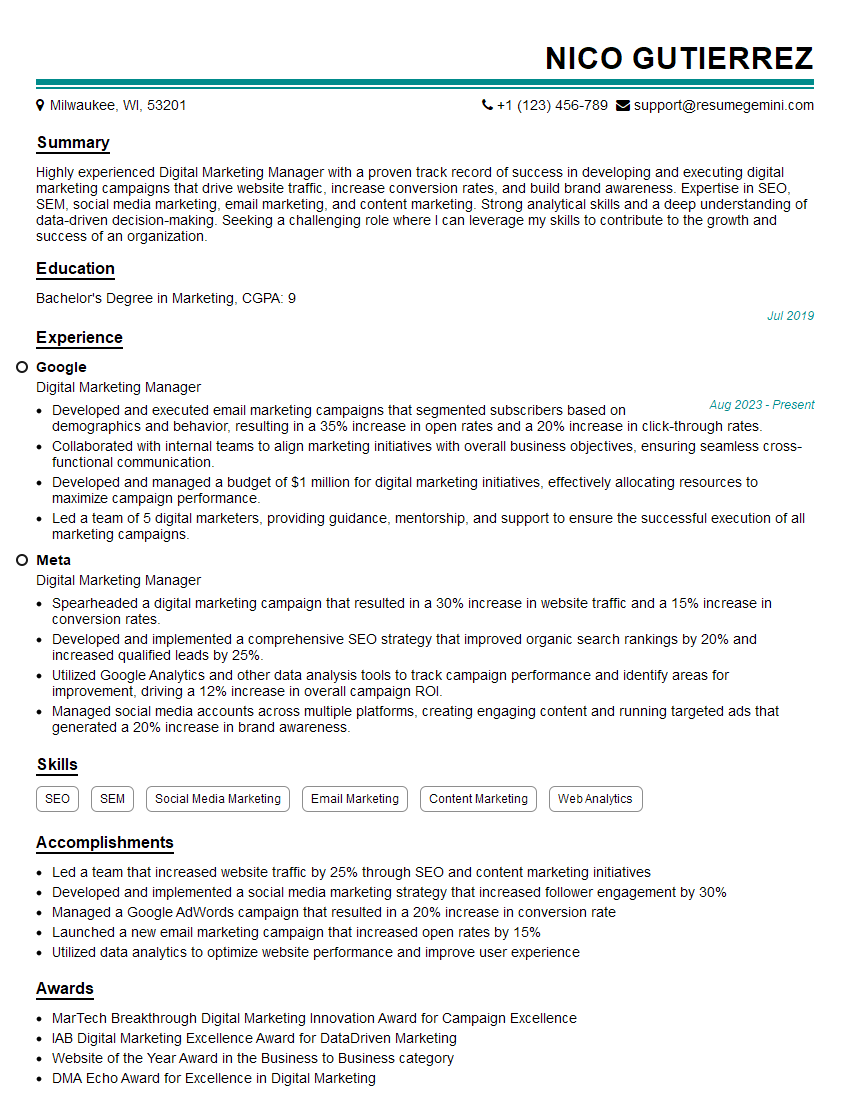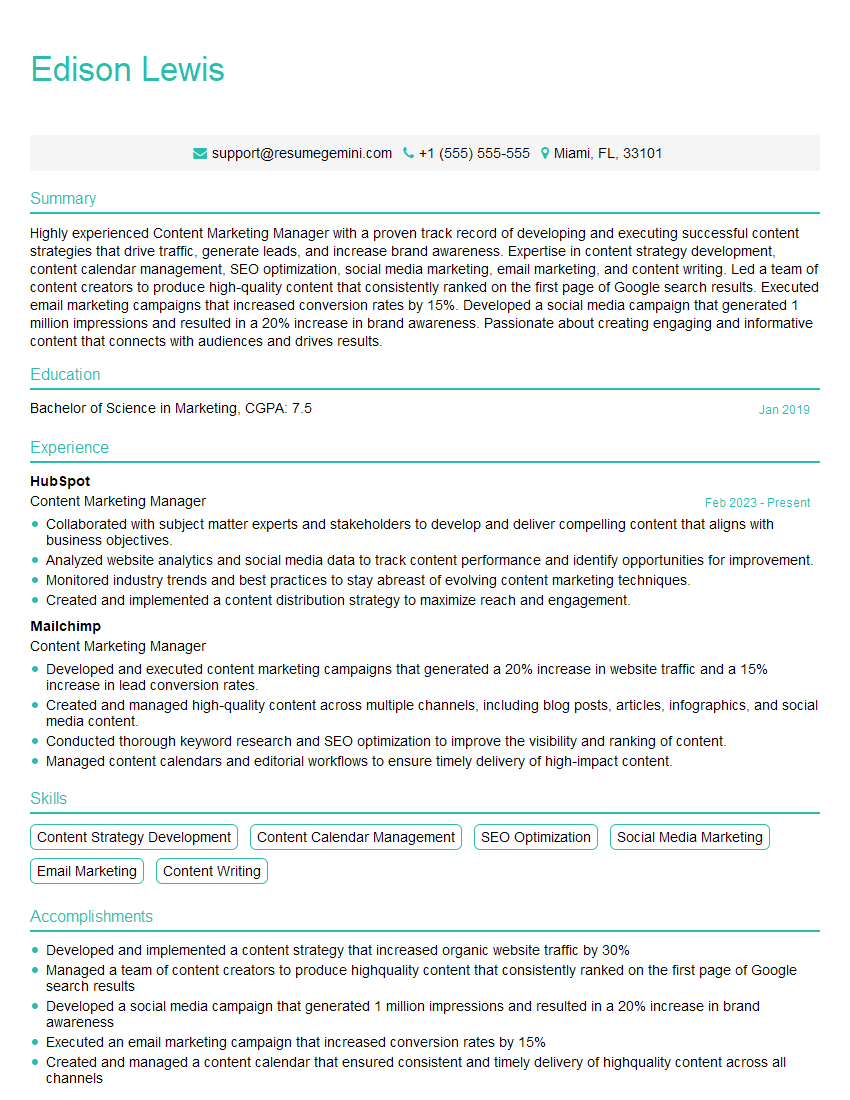Preparation is the key to success in any interview. In this post, we’ll explore crucial Knowledge of Marketing interview questions and equip you with strategies to craft impactful answers. Whether you’re a beginner or a pro, these tips will elevate your preparation.
Questions Asked in Knowledge of Marketing Interview
Q 1. Explain the difference between inbound and outbound marketing.
Inbound and outbound marketing represent two fundamentally different approaches to reaching your target audience. Think of it like fishing: outbound marketing is like casting a wide net, hoping to catch some fish (customers), while inbound marketing is like creating a thriving ecosystem in your pond to attract fish (customers) naturally.
Outbound Marketing: This is a more traditional approach that involves actively pushing your message out to potential customers. Examples include:
- Print advertising: Newspapers, magazines, brochures.
- Television and radio commercials:
- Cold calling and emailing:
- Direct mail:
- Trade shows and conferences:
Outbound marketing is often interruption-based; it forces your message onto the audience, whether they want it or not. It can be expensive and has a lower conversion rate.
Inbound Marketing: This approach focuses on attracting customers by creating valuable and relevant content that addresses their needs and pain points. Customers find you organically through search engines, social media, or referrals. Examples include:
- Blog posts and articles:
- SEO optimization:
- Social media marketing:
- Infographics and videos:
- Email marketing (permission-based):
Inbound marketing is permission-based; customers opt-in to receive your content and engage with your brand. It’s generally more cost-effective and builds stronger customer relationships.
Q 2. Describe your experience with SEO best practices.
My experience with SEO best practices is extensive. I’ve successfully implemented strategies to improve organic search rankings for various clients across diverse industries. This includes keyword research using tools like SEMrush and Ahrefs, on-page optimization (title tags, meta descriptions, header tags, image alt text, and internal linking), off-page optimization (backlink building, social media promotion), and technical SEO (site speed optimization, mobile-friendliness, XML sitemaps, and robots.txt).
For example, I once worked with a small e-commerce business struggling with low website traffic. Through a comprehensive SEO audit, I identified several issues: poor site structure, thin content, and a lack of high-quality backlinks. I implemented a strategy that included creating high-quality product descriptions, optimizing existing content for relevant keywords, and building backlinks through guest posting and outreach. Within six months, their organic traffic increased by over 70%, resulting in a significant boost in sales.
Q 3. How do you measure the success of a marketing campaign?
Measuring the success of a marketing campaign requires a multifaceted approach, focusing on both quantitative and qualitative data. It’s not enough to simply look at one metric; a holistic view is crucial.
Key Metrics to Consider:
- Website Traffic (Google Analytics): Track website visits, bounce rate, time on site, and pages per visit to understand engagement.
- Conversion Rate: Measure the percentage of visitors who complete a desired action (e.g., purchase, sign-up, download).
- Return on Investment (ROI): Calculate the profit generated relative to the cost of the campaign.
- Customer Acquisition Cost (CAC): Determine the average cost of acquiring a new customer.
- Brand Awareness (Social Listening): Monitor social media mentions, brand sentiment, and reach to assess brand perception.
- Customer Satisfaction (Surveys & Feedback): Gather feedback to understand customer experience and identify areas for improvement.
Example: If a campaign aimed to increase website sign-ups, we’d monitor the number of new sign-ups, the cost per sign-up, and customer feedback on the signup process to assess its overall effectiveness.
Q 4. What is your experience with A/B testing and what are some key considerations for effective A/B testing?
A/B testing (also known as split testing) involves comparing two versions of a webpage or marketing element (e.g., email subject line, button color) to determine which performs better. I have extensive experience designing and implementing A/B tests to optimize conversion rates and user experience.
Key Considerations for Effective A/B Testing:
- Clearly Defined Hypothesis: Start with a specific hypothesis about what you expect to improve (e.g., changing the button color will increase click-through rates).
- One Variable at a Time: Only change one element at a time to isolate the impact of each change.
- Sufficient Sample Size: Ensure enough traffic is directed to each version to obtain statistically significant results. Tools like online calculators can help determine the necessary sample size.
- Appropriate Duration: Run the test long enough to account for variations in traffic and user behavior.
- Statistical Significance: Use statistical analysis to determine if the difference in performance between the two versions is significant or due to random chance.
Example: I once A/B tested two different email subject lines for a client’s newsletter. One subject line was more direct and benefit-driven, while the other was more intriguing and question-based. The A/B test revealed a 15% higher open rate for the benefit-driven subject line, leading to a significant increase in engagement and conversions.
Q 5. What are some key performance indicators (KPIs) you track for digital marketing campaigns?
The KPIs I track for digital marketing campaigns vary depending on the specific goals and objectives, but some key indicators consistently provide valuable insights:
- Website Traffic: Total visits, unique visitors, bounce rate, pages per visit.
- Conversion Rate: Percentage of website visitors who complete a desired action (e.g., purchase, signup).
- Customer Acquisition Cost (CAC): Cost of acquiring a new customer.
- Return on Ad Spend (ROAS): Revenue generated from advertising campaigns.
- Customer Lifetime Value (CLTV): Predicted revenue from a single customer over their entire relationship with the business.
- Engagement Metrics (Social Media): Likes, shares, comments, reach, follower growth.
- Email Marketing Metrics: Open rates, click-through rates, conversion rates.
By monitoring these KPIs, I can track progress towards campaign goals, identify areas for improvement, and make data-driven decisions to optimize campaign performance.
Q 6. Explain the concept of a marketing funnel and its stages.
The marketing funnel is a visual representation of the customer journey, from initial awareness to becoming a loyal advocate. It’s a crucial framework for understanding how customers interact with your brand and optimizing your marketing efforts.
Stages of the Marketing Funnel:
- Awareness: Potential customers become aware of your brand or product through various marketing channels (e.g., social media, search engine results, advertising).
- Interest: Potential customers show interest in your brand or product by engaging with your content, visiting your website, or requesting more information.
- Decision: Potential customers evaluate your brand or product against competitors and decide whether or not to make a purchase.
- Action: Potential customers take action by making a purchase, signing up for a trial, or requesting a quote.
- Loyalty/Advocacy: Existing customers become loyal advocates for your brand, recommending your products or services to others.
Understanding the funnel helps marketers tailor their messaging and content to each stage, maximizing conversion rates at every step. For instance, at the awareness stage, the focus might be on brand building and broad reach, whereas at the decision stage, the focus shifts to providing detailed product information and compelling calls to action.
Q 7. Describe your experience with social media marketing and platform selection.
I possess extensive experience in social media marketing, leveraging various platforms to achieve diverse marketing objectives. Platform selection depends critically on the target audience and campaign goals. There’s no one-size-fits-all approach.
Experience and Platform Selection:
- Facebook: Excellent for building brand awareness, targeting specific demographics, and running advertising campaigns. I’ve utilized Facebook’s robust targeting options to reach niche audiences and achieve high conversion rates.
- Instagram: Ideal for visual storytelling and reaching younger demographics. I’ve created engaging visual content, leveraging Instagram Stories and Reels to increase brand visibility and engagement.
- LinkedIn: Best suited for B2B marketing and professional networking. I’ve utilized LinkedIn to build professional relationships, generate leads, and share thought leadership content.
- Twitter: Effective for real-time engagement and disseminating information quickly. I’ve leveraged Twitter for customer service, brand monitoring, and creating engaging conversations.
- TikTok: Ideal for reaching a younger audience through short-form video content. I have experience crafting viral-worthy content that increases brand reach and awareness.
I always conduct thorough audience research to determine which platforms offer the greatest reach and engagement potential for a given campaign. For instance, a B2B campaign would likely prioritize LinkedIn, while a campaign targeting teenagers might focus on TikTok and Instagram.
Q 8. How do you develop a marketing budget?
Developing a marketing budget requires a strategic approach that aligns with overall business objectives. It’s not just about allocating funds; it’s about prioritizing investments for maximum ROI. I typically start with defining clear marketing goals – what are we trying to achieve? Increased brand awareness? Lead generation? Sales growth? Once goals are established, I use a combination of top-down and bottom-up budgeting methods.
Top-down budgeting starts with the overall marketing budget allocated by senior management. Then I allocate those funds across different marketing channels and activities based on their potential contribution to the goals. Bottom-up budgeting involves estimating the cost of individual marketing activities (e.g., PPC campaigns, content creation, social media management) and summing them up to get the total budget. I usually prefer a hybrid approach that balances both these perspectives.
Next, I analyze historical data (if available) to understand past marketing campaign performance and ROI. This helps inform future budget allocations. For example, if social media marketing consistently outperforms email marketing in terms of lead generation, I’ll allocate a larger portion of the budget to social media. I also consider market research and competitive analysis to identify opportunities and adjust the budget accordingly. Finally, regular monitoring and adjustments are crucial. I build in contingency funds to handle unexpected expenses or opportunities and regularly review the budget’s performance against the defined goals.
For instance, in my previous role, we initially allocated a larger budget to traditional print advertising. However, after analyzing campaign data showing low engagement and conversion rates, we shifted a significant portion of the budget towards digital marketing, particularly SEO and social media, resulting in a substantial improvement in ROI.
Q 9. What is your experience with content marketing and content strategy?
Content marketing and strategy are fundamental to my approach. I believe in creating high-quality, valuable content that resonates with the target audience and drives engagement. My experience spans various content formats, including blog posts, website copy, infographics, videos, social media posts, ebooks, and case studies.
A strong content strategy starts with understanding the audience: their needs, pain points, and preferred content formats. Keyword research is crucial to ensure content is discoverable through search engines. I then develop a content calendar, outlining the topics, formats, and publishing schedule. This ensures consistency and keeps content aligned with business objectives.
For example, in a recent project, we implemented a content strategy for a software company focused on educating potential clients about the complexities of data migration. We created a series of blog posts, infographics, and videos that explained the process step-by-step, addressing common concerns and demonstrating the software’s capabilities. This resulted in a significant increase in leads and conversions.
I also emphasize using analytics to measure content performance and iterate. Tools like Google Analytics help track website traffic, engagement metrics, and conversions. This data informs content optimization and future content creation.
Q 10. What are some common marketing analytics tools you’ve used?
I’ve used a variety of marketing analytics tools throughout my career, each chosen based on the specific needs of the project and the data we needed to track. Some of the most common and effective tools I’ve utilized include:
- Google Analytics: Essential for website traffic analysis, user behavior tracking, conversion tracking, and campaign performance measurement. I use it to understand user demographics, popular pages, and conversion funnels.
- Google Ads: For analyzing the performance of paid search campaigns, including keyword performance, click-through rates (CTR), conversion rates, and cost per acquisition (CPA).
- Social Media Analytics Platforms (e.g., Facebook Insights, Twitter Analytics): These tools provide data on social media engagement, reach, demographics, and campaign performance. I use them to gauge audience interest and sentiment.
- Marketing Automation Platforms (e.g., HubSpot, Marketo): These platforms offer comprehensive data on email marketing campaigns, lead nurturing effectiveness, and overall customer journey.
- CRM Systems (e.g., Salesforce, Zoho CRM): I use these to analyze sales data, customer behavior, and identify trends that help inform marketing strategies.
The choice of tools depends on the specific marketing goals and the available budget. I always focus on integrating the data from these different platforms to get a holistic view of campaign performance.
Q 11. How do you stay updated on the latest marketing trends?
Staying updated on the latest marketing trends is critical for success. I utilize a multi-pronged approach:
- Industry Publications and Blogs: I regularly read leading marketing publications, blogs, and websites (e.g., MarketingProfs, Neil Patel, Search Engine Journal) to stay informed about the latest strategies, technologies, and best practices.
- Industry Events and Conferences: Attending conferences and webinars provides opportunities to learn from experts, network with other professionals, and gain insights into emerging trends firsthand.
- Online Courses and Certifications: Platforms like Coursera, Udemy, and LinkedIn Learning offer courses and certifications to enhance my knowledge and skills in specific areas of marketing.
- Following Industry Influencers on Social Media: I actively follow thought leaders and key players in the marketing industry on platforms like Twitter and LinkedIn to access their insights and analyses.
- Competitor Analysis: I continuously monitor my competitors’ marketing activities to identify successful strategies and adapt them to my own work.
This combination of active learning and engagement ensures I remain at the forefront of industry developments.
Q 12. Explain your understanding of search engine marketing (SEM).
Search Engine Marketing (SEM) encompasses all marketing efforts designed to increase the visibility of a website or a brand in search engine results pages (SERPs). It primarily involves paid advertising, unlike Search Engine Optimization (SEO), which focuses on organic search results. SEM strategies leverage platforms like Google Ads, Bing Ads, and other search engine advertising networks.
Key components of SEM include:
- Keyword Research: Identifying relevant keywords that potential customers use to search for products or services.
- Ad Copywriting: Crafting compelling ad copy that attracts clicks and drives conversions.
- Bidding Strategies: Determining how much to bid on keywords based on budget, competition, and desired ROI.
- Landing Page Optimization: Creating high-converting landing pages that effectively capture leads and drive sales.
- Campaign Monitoring and Optimization: Continuously tracking and analyzing campaign performance to identify areas for improvement and maximize ROI. This includes A/B testing different ad creatives and landing pages.
For example, a successful SEM campaign for an e-commerce store might involve targeting specific keywords related to their products, creating visually appealing ads with clear calls to action, and directing traffic to highly optimized landing pages that encourage purchases.
Q 13. Describe your experience with email marketing best practices.
Email marketing, when done effectively, is a powerful tool for nurturing leads and driving conversions. My experience encompasses various aspects of email marketing best practices, including:
- List Building and Segmentation: Creating targeted email lists based on demographics, behavior, and interests. Segmentation allows for personalized messaging, which dramatically improves open and click-through rates.
- Email Design and Content Creation: Crafting visually appealing, mobile-responsive emails with compelling content that encourages engagement. This includes using clear subject lines, concise copy, and strong calls to action.
- A/B Testing: Experimenting with different subject lines, email content, and calls to action to optimize email performance. This data-driven approach ensures continuous improvement.
- Automation: Implementing automated email sequences for lead nurturing, onboarding new customers, or sending follow-up messages after purchases. This improves efficiency and consistency.
- Deliverability and Compliance: Adhering to email marketing best practices to maintain a high deliverability rate and comply with anti-spam laws (e.g., CAN-SPAM Act). This includes using reputable email marketing platforms and maintaining a clean email list.
For instance, in a past project, we segmented our email list based on customer purchase history and behavior. We then created personalized email campaigns tailored to each segment, resulting in a significant increase in sales and customer lifetime value.
Q 14. How do you handle a marketing campaign that’s underperforming?
When a marketing campaign underperforms, it’s crucial to act swiftly and systematically. I follow a structured approach to diagnose the problem and implement corrective actions:
- Analyze the Data: The first step is to thoroughly analyze all available data from the campaign. This includes website analytics, email marketing metrics, social media engagement, and any other relevant data points. Identifying specific areas of weakness is key.
- Identify the Root Cause: Based on the data analysis, I identify the likely reasons for the underperformance. This could be due to issues with targeting, messaging, creative assets, landing page optimization, or technical glitches.
- Develop and Implement Solutions: Once the root cause is identified, I develop and implement specific solutions to address the problem. This might involve adjusting targeting parameters, refining messaging, creating new creative assets, optimizing landing pages, or fixing technical issues.
- Monitor and Iterate: After implementing changes, I closely monitor the campaign’s performance to assess the effectiveness of the solutions. I make further adjustments and iterations based on the observed results. This is a continuous process of improvement.
- Document Findings and Learnings: Finally, I document the entire process – the initial problem, the diagnostic analysis, the solutions implemented, and the outcomes. This helps to avoid similar issues in the future and builds a repository of learnings.
For example, if a social media campaign is underperforming, the data might reveal low engagement or a poor click-through rate. This could be due to irrelevant targeting, uninteresting content, or poor ad creative. Addressing these issues, such as refining targeting, creating more engaging content, and testing different visuals, could turn the campaign around.
Q 15. What’s your experience with marketing automation tools?
Marketing automation tools are indispensable for streamlining marketing processes and improving efficiency. My experience spans several platforms, including HubSpot, Marketo, and Pardot. I’ve used these tools to automate repetitive tasks like email marketing campaigns, social media posting, lead nurturing, and customer segmentation. For example, with HubSpot, I designed automated email sequences that triggered based on user behavior, such as website visits or form submissions. This resulted in a significant increase in lead conversion rates. In another project using Marketo, I implemented a lead scoring system to prioritize high-potential leads for the sales team, saving them valuable time and improving sales productivity. My expertise lies not just in using these tools, but in strategically integrating them into a comprehensive marketing strategy to maximize their impact.
Career Expert Tips:
- Ace those interviews! Prepare effectively by reviewing the Top 50 Most Common Interview Questions on ResumeGemini.
- Navigate your job search with confidence! Explore a wide range of Career Tips on ResumeGemini. Learn about common challenges and recommendations to overcome them.
- Craft the perfect resume! Master the Art of Resume Writing with ResumeGemini’s guide. Showcase your unique qualifications and achievements effectively.
- Don’t miss out on holiday savings! Build your dream resume with ResumeGemini’s ATS optimized templates.
Q 16. Explain your experience with market research and competitor analysis.
Market research and competitor analysis are critical for developing effective marketing strategies. My approach is multifaceted, starting with defining clear objectives. For example, if we’re launching a new product, the research might focus on understanding target audience needs, preferences, and pain points. I utilize both quantitative and qualitative research methods. Quantitative research might involve surveys and data analysis to understand market size and trends. Qualitative research would involve focus groups or interviews to gain deeper insights into customer attitudes and perceptions. Competitor analysis includes examining their strengths, weaknesses, strategies, and market positioning. Tools like SEMrush and SimilarWeb help in gathering data on website traffic, keyword rankings, and social media engagement. I then synthesize this data to identify opportunities, threats, and competitive advantages. For example, I once identified a gap in the market for a specific feature that our competitors lacked, which helped us position our product uniquely and effectively.
Q 17. Describe your understanding of branding and brand development.
Branding is more than just a logo; it’s the overall perception and experience customers have with a company. Brand development involves creating a unique identity that resonates with the target audience. This includes defining the brand’s personality, values, and messaging. A strong brand helps differentiate a company from its competitors and fosters customer loyalty. My experience involves developing brand strategies from the ground up, including defining brand guidelines, creating brand assets (like logos and style guides), and overseeing consistent brand messaging across all channels. For example, I helped a startup define its brand positioning as a ‘disruptive innovator’ which guided all subsequent marketing efforts, from website design to social media content. Brand development requires a thorough understanding of the target market and a clear articulation of the brand’s unique value proposition.
Q 18. How do you measure brand awareness?
Measuring brand awareness involves assessing the extent to which target audiences recognize and recall a brand. There are several methods to do this. Surveys are a direct approach, asking consumers about their familiarity with the brand. Social listening tracks brand mentions and sentiment on social media platforms. Website analytics can show brand searches and traffic sources. Brand lift studies measure changes in awareness before and after a marketing campaign. Market research reports provide insights into brand recognition within a specific market segment. The specific metrics used depend on the campaign goals and the overall marketing strategy. For instance, a high percentage of aided recall (when consumers recognize the brand after being given prompts) might indicate strong brand recognition, while a significant increase in social media mentions might suggest a successful campaign in raising brand awareness.
Q 19. How do you create a marketing plan?
Creating a marketing plan is a strategic process that starts with defining clear objectives, such as increasing brand awareness, generating leads, or driving sales. Next, we identify the target audience, understanding their needs, preferences, and behaviors. Then, I develop a marketing strategy outlining the tactics to achieve the objectives. This strategy will consider the marketing mix (product, price, place, promotion) and will incorporate various channels such as digital marketing (SEO, SEM, social media), content marketing, email marketing, and public relations. A detailed budget is essential, allocating resources to each activity. A timeline defines key milestones and deadlines. Finally, regular monitoring and analysis are crucial, tracking progress against objectives and making necessary adjustments. The entire process is iterative and involves constant refinement based on data analysis and market feedback. For example, a recent marketing plan for a client included a phased rollout of a new product, starting with a targeted social media campaign followed by email marketing and public relations efforts.
Q 20. Explain your experience with customer relationship management (CRM) systems.
Customer Relationship Management (CRM) systems are vital for managing customer interactions and data. My experience includes working with Salesforce, HubSpot CRM, and Zoho CRM. These systems help organize and track customer information, interactions, and sales activities. I’ve used CRMs to segment customers based on demographics, purchase history, and engagement levels. This enables personalized marketing and improved customer service. For instance, using Salesforce, I developed automated workflows for lead qualification and nurturing, leading to increased sales conversion rates. CRMs are also crucial for tracking key metrics, like customer lifetime value and churn rate. By analyzing this data, we can identify areas for improvement in customer retention and satisfaction. The effective use of a CRM necessitates a deep understanding of its capabilities and its integration with other marketing and sales tools.
Q 21. How do you use data to inform marketing decisions?
Data is the cornerstone of informed marketing decisions. My approach involves collecting data from various sources, including website analytics (Google Analytics), CRM systems, social media platforms, and market research. This data provides insights into customer behavior, campaign performance, and market trends. I use data analysis techniques to identify patterns, trends, and correlations. For example, A/B testing allows us to compare the performance of different marketing materials and optimize campaigns for better results. Analyzing website analytics reveals which content resonates most with the audience, helping us create more engaging and effective content. Furthermore, using CRM data, we can identify high-value customers and tailor our messaging to their specific needs. Essentially, data-driven marketing allows us to move beyond intuition and make decisions grounded in evidence, leading to greater efficiency and ROI.
Q 22. What is your experience with influencer marketing?
Influencer marketing leverages individuals with a significant social media following to promote products or brands. My experience encompasses a multifaceted approach, from identifying and vetting suitable influencers to negotiating contracts and monitoring campaign performance. I’ve worked with micro-influencers (those with smaller, highly engaged audiences) for targeted campaigns, as well as macro-influencers for broader reach. For example, in a recent campaign for a sustainable fashion brand, I partnered with several micro-influencers who aligned with the brand’s values and aesthetic, resulting in a 25% increase in website traffic and a 15% increase in sales compared to previous campaigns. This involved careful selection based on audience demographics, engagement rates, and content quality. I also track key performance indicators (KPIs) such as reach, engagement (likes, comments, shares), website clicks, and conversions to measure campaign effectiveness and make data-driven adjustments.
Q 23. Describe your experience with developing marketing collateral.
Developing marketing collateral is a crucial aspect of any marketing strategy. My experience includes creating a wide range of materials, including brochures, flyers, website copy, email marketing campaigns, social media posts, and presentations. I’m proficient in various design software and understand the importance of clear, concise messaging tailored to the specific target audience. For instance, for a technology company, I developed a series of concise, visually appealing infographics explaining complex technical concepts in a way that was easily understood by non-technical audiences. This involved working closely with the product team to understand the key features and benefits, and then translating that information into compelling visuals and text. The resulting collateral significantly increased lead generation and brand awareness.
Q 24. Explain your understanding of the customer journey.
The customer journey maps out the stages a customer goes through from initial awareness of a product or brand to post-purchase engagement. Understanding this journey is vital for crafting effective marketing strategies. It typically involves several stages: Awareness (learning about the product), Consideration (evaluating options), Decision (making a purchase), Action (using the product), and Advocacy (becoming a brand loyalist). I use this understanding to tailor marketing messages and channels at each stage. For example, I might use social media advertising to build awareness, email marketing for nurturing leads during the consideration phase, and loyalty programs to foster advocacy. Analyzing customer data and feedback allows for continuous improvement and optimization of the customer journey and overall marketing strategy.
Q 25. How do you manage multiple marketing projects simultaneously?
Managing multiple marketing projects simultaneously requires strong organizational skills and effective time management. I utilize project management tools like Asana or Trello to track tasks, deadlines, and progress. I prioritize projects based on urgency and importance, delegating tasks when appropriate. Regular progress meetings with team members ensure everyone is aligned and informed. Furthermore, I break down large projects into smaller, manageable tasks, making them easier to track and complete. Clear communication with stakeholders is key to keeping everyone updated on progress and addressing any potential issues promptly. For example, when launching three simultaneous campaigns, I used a Gantt chart to visualize timelines, assigned team members specific tasks with deadlines, and held daily stand-up meetings to discuss progress and challenges.
Q 26. Describe your experience with marketing analytics dashboards.
Marketing analytics dashboards are crucial for monitoring campaign performance and making data-driven decisions. My experience includes using tools like Google Analytics, Data Studio, and other business intelligence platforms to create custom dashboards that visualize key metrics such as website traffic, conversion rates, customer acquisition costs, and ROI. I’m proficient in interpreting data, identifying trends, and using this information to optimize campaigns. For instance, a dashboard I created for an e-commerce client showed a significant drop in conversion rates from a specific landing page. By analyzing the data further, we identified the problem and implemented changes, resulting in a 10% increase in conversions within a month. Dashboards allow for quick identification of issues and facilitate informed, efficient marketing adjustments.
Q 27. How do you adapt your marketing strategies to different target audiences?
Adapting marketing strategies to different target audiences is essential for maximizing impact. I begin by conducting thorough market research to understand each target audience’s demographics, psychographics (values, interests, lifestyle), and buying behavior. Then, I tailor messaging, channels, and creative assets to resonate with each group. For example, a campaign targeting young adults might utilize social media platforms like TikTok and Instagram with short, engaging video content, whereas a campaign for a more mature audience might leverage email marketing and print advertising with a more formal tone. This personalized approach significantly improves engagement and conversion rates by ensuring the right message reaches the right audience at the right time.
Q 28. Explain your understanding of marketing ROI (Return on Investment).
Marketing ROI (Return on Investment) measures the effectiveness of marketing activities by comparing the cost of the investment to the revenue generated. It’s a crucial metric for demonstrating the value of marketing efforts. Calculating ROI involves subtracting the cost of marketing campaigns from the revenue generated, then dividing the result by the cost of the campaign and multiplying by 100 to express it as a percentage. ROI = [(Revenue - Cost) / Cost] x 100. For example, if a marketing campaign cost $10,000 and generated $30,000 in revenue, the ROI would be 200%. Tracking ROI helps to justify marketing investments, identify high-performing campaigns, and optimize future strategies. A strong understanding of ROI helps focus on initiatives with the highest potential return, improving overall marketing efficiency and profitability.
Key Topics to Learn for Your Marketing Knowledge Interview
- Marketing Strategy & Planning: Understand the process of developing a comprehensive marketing strategy, including market research, target audience identification, and setting measurable goals. Consider how different marketing strategies (e.g., digital, traditional) can be integrated effectively.
- Digital Marketing Fundamentals: Demonstrate proficiency in key digital channels like SEO, SEM, social media marketing, email marketing, and content marketing. Be ready to discuss practical applications and campaign optimization techniques.
- Marketing Analytics & Measurement: Showcase your understanding of key performance indicators (KPIs) and how to track, analyze, and interpret marketing data to inform future strategies. Discuss experience with analytics tools and reporting methods.
- Branding & Positioning: Explain your understanding of brand development, brand identity, and brand messaging. Prepare examples of successful branding strategies and how they contribute to business success.
- Marketing Communication: Discuss different communication channels and their effectiveness in reaching target audiences. Prepare examples demonstrating understanding of integrated marketing communication strategies.
- Customer Relationship Management (CRM): Explain your understanding of CRM systems and how they are used to manage customer interactions, improve customer satisfaction, and build loyalty. Be ready to discuss practical applications.
- Market Research & Analysis: Demonstrate your ability to conduct and interpret market research to understand customer needs and market trends. Be prepared to discuss different research methodologies and their applications.
- Budgeting & Resource Allocation: Show your understanding of developing and managing marketing budgets effectively, allocating resources across different channels and campaigns to maximize ROI.
Next Steps
Mastering marketing knowledge is crucial for career advancement in today’s competitive landscape. A strong understanding of these concepts will significantly enhance your interview performance and open doors to exciting opportunities. To maximize your chances, create an ATS-friendly resume that highlights your skills and experience effectively. ResumeGemini is a trusted resource that can help you build a professional resume that stands out. Examples of resumes tailored to showcase your Marketing Knowledge are available—use them to inspire your own!
Explore more articles
Users Rating of Our Blogs
Share Your Experience
We value your feedback! Please rate our content and share your thoughts (optional).
